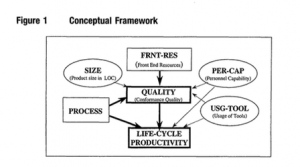Week5_Krishnan et al. (2000)_Vicky Xu
An Empirical Analysis of Productivity and Quality in Software Products
Most of prior empirical research on software maintenance has not been able to provide answers to problems related to cost overrun since productivity and quality modeling efforts have often considered either the productivity or the quality. And empirical evidence on the effect of process factors is mostly restricted to case studies and experience reports of a few projects.
Krishnan et al. (2000) fill this void by examining the relationship between life-cycle productivity and conformance quality in software products. Krishnan et al. (2000) address the research questions as following:
- What is the trade-off between quality and life-cycle productivity?
- What are the effects of the development process on life-cycle productivity and quality?
- Does up-front resource deployment pay off?
- What are the effects of development resources on productivity and quality?
The conceptual elements of the research model in this paper (is shown in Figure 1., p. 748) as the following diagram:
Krishnan et al. (2000) collected data on commercial software projects of a leading vendor. Then, Krishnan et al. (2000) consider the software process areas specified in the Capability Maturity Model (CMM) that are relevant to software productivity and quality, and consider alternate specifications (linear versus nonlinear) for the relationship between various explanatory variables and quality or life-cycle productivity. And the estimation procedures include OLS, SUR, and 2SLS.
Krishnan et al. (2000) find: (1) Evidence for both direct and indirect (through quality improvement) effects of personnel capability on software development and maintenance productivity. (2) Investments in the early stages of software development improve quality. (3) Several quality drivers in software products.
Three main contributions of this paper are: (1) Developing models for software life-cycle productivity that include both development and maintenance costs. (2) The models can capture the effect of the software development process measured at the project level based on the practices specified in CMM key process areas on life-cycle productivity and quality. (3) Studying the effect of front-end investment in product development on conformance quality. (4) Validating the proposed models by using primary data on system software projects of a large commercial software developer.



Leave a Reply
You must be logged in to post a comment.